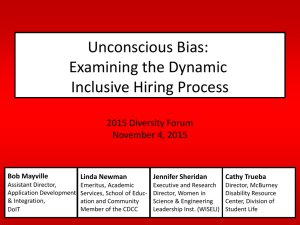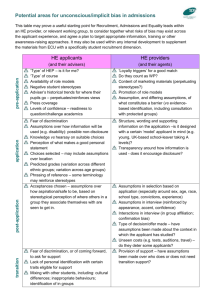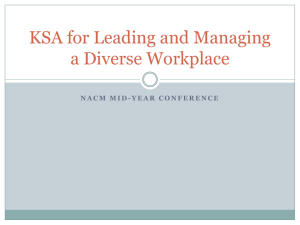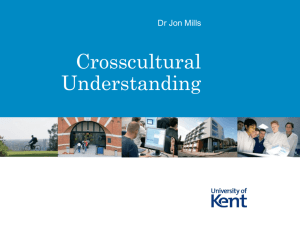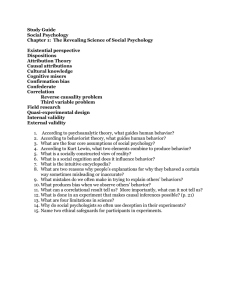Fostering a Diverse Faculty: Reducing Bias in the Search Process
advertisement
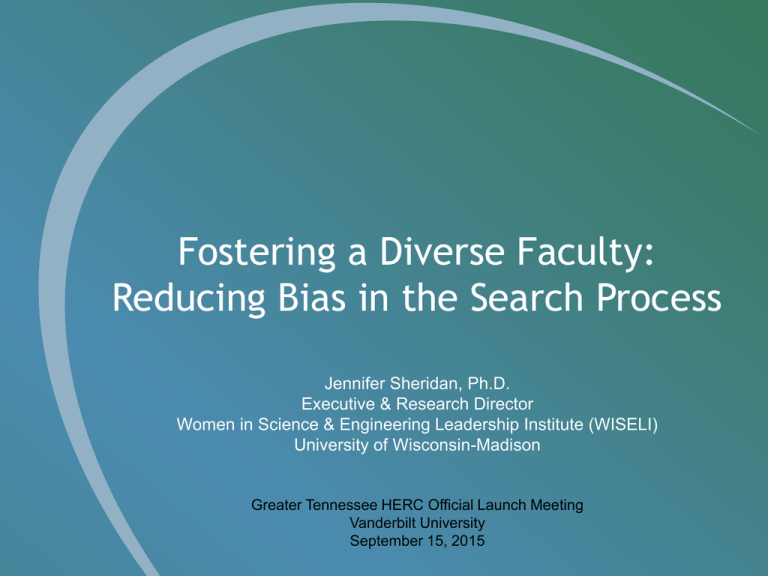
Fostering a Diverse Faculty: Reducing Bias in the Search Process Jennifer Sheridan, Ph.D. Executive & Research Director Women in Science & Engineering Leadership Institute (WISELI) University of Wisconsin-Madison Greater Tennessee HERC Official Launch Meeting Vanderbilt University September 15, 2015 ABOUT WISELI Research institute at the University of Wisconsin-Madison Mission: Advancing and promoting women in academic Science, Technology, Mathematics and Medicine (STEMM) – focus on faculty Broader goals – fostering a diverse faculty body Funding: NSF ADVANCE, NIH, Campus support WHY PROVIDE EDUCATION FOR FACULTY SEARCH COMMITTEES? Faculty members receive little education about the search process A faculty search is costly (time and money) Provides an opportunity to achieve campus goals of diversifying the faculty STAGES OF THE FACULTY SEARCH PROCESS Committee Formation and Committee Processes Recruitment of Candidates Evaluation of Candidates Bias Awareness Bias Reduction Interview Processes Closing the Deal RUN AN EFFECTIVE AND EFFICIENT SEARCH COMMITTEE Search Committee Processes Composition of the search committee Choose a chair who is committed to diversity Build a diverse search committee Establishment of expectations and ground rules Attendance, decision-making, confidentiality Know the laws, university policies Role of the search committee and its members Discussion of diversity Creation of the position description Avoid biased language “Sell” the department and university Carefully craft a statement about the importance of diversity to the department Decide on and prioritize review criteria ACTIVELY RECRUIT AN EXCELLENT AND DIVERSE POOL OF CANDIDATES Actively Recruit Short Term Recruiting Placing advertisements Word-of-mouth/networking Professional organizations/special groups or caucuses Grant or fellowship programs targeting underrepresented scholars Long Term Recruiting Conferences Invited speaker series within a department Department alumni from underrepresented groups RAISE AWARENESS OF UNCONSCIOUS ASSUMPTIONS AND THEIR INFLUENCE ON EVALUATION OF APPLICANTS What is “Unconscious Bias”? A substantial body of evidence demonstrates that most people—men and women—hold unconscious biases about groups of people. Depending on the discipline, unconscious biases can also be referred to as: Schemas Stereotypes Mental models Cognitive shortcuts Statistical discrimination Implicit associations Spontaneous trait inference System 1 thinking The tendency of our minds to apply characteristics of groups (real or imagined) to our judgments about individual group members What is “Unconscious Bias”? (Cont’d) Most of us routinely rely on unconscious assumptions even though we intend to be fair and believe that we are fair. The human brain works by categorizing people, objects, and events around us. This allows us to quickly and efficiently organize and retrieve information. BUT! This process is not infallible. Stereotypes about men? Stereotypes about women? Stereotypes about scientists? Gender Stereotypes Men are agentic: decisive, strong, competitive, ambitious, independent, willing to take risks Women are communal: nurturing, nice, gentle, supportive, sympathetic, dependent These stereotypes lead to expectancy bias and assumptions of occupational role congruity Prescriptive norms: how women and men should and should not be Social penalties for violating prescriptive gender norms Works of multiple authors over 30 years: e.g., Ben 1974; Broverman 2010; Eagly 2002, 2003, 2007; Heilman 1984, 1995, 2001, 2004, 2007 Racial/Ethnic Stereotypes Common racial/ethnic stereotypes African-Americans1 Chinese2 Latinos3 Athletic Rhythmic Low in intelligence Lazy Poor Loud Criminal Hostile Ignorant Disciplined Competitive Loyal to family ties Scientifically minded Business oriented Strong values Clever Serious Determined Logical Wise Poor Have many children Illegal immigrants Dark-skinned Uneduated Family-oriented Lazy Day laborers Unintelligent Loud Gangsters 1. Devine and Elliot. (1995) Are Racial Stereotypes Really Fading? The Princeton Trilogy Revisited. Personality and Social Psychology Bulletin 21 (11): 1139–50. 2. Madon et al. (2001) Ethnic and National Stereotypes: The Princeton Trilogy Revisited and Revised. Personality and Social Psychology Bulletin 27(8) 996–1010. 3. Ghavami and Peplau. (2015) An Intersectional Analysis of Gender and Ethnic Stereotypes: Testing Three Hypotheses. Psychology of Women Quarterly 37(1): 113-127. Research on Bias and Prejudice Randomized, controlled studies (“Goldberg” design) Give a randomized group of evaluators a piece of work (e.g., CV/résumé, grant application, job application, research article) with a gender, racial, or other indicator of group membership Compare evaluations Real life studies Evaluate actual résumés/curriculum vitae, job performance, letters of recommendations, etc. Evaluation of Curriculum Vitae Curriculum vitae of an actual applicant evaluated by 238 academic psychologists (118 male, 120 female) One CV – Junior level (assistant professor) One CV – Senior level (tenurable) Randomly assigned male or female name to each CV Karen Miller vs. Brian Miller Measure strength of teaching, research, service activities. Indicate likeliness to hire candidate Evaluators were asked to send materials back to researchers along with their ratings Steinpreis et al. 1999. “The impact of gender on the review of the curricula vitae of job applicants and tenure candidates: A national empirical study.” Sex Roles 41: 509-528. Evaluation of Curriculum Vitae For entry-level CV: Academic psychologists were more likely to hire “male” applicant and gave “male” applicant higher ratings for research, teaching and service Male and female evaluators were equally likely to favor hiring the “male” applicant For higher-level CV: Academic psychologists were equally likely to hire/tenure the “male” and “female” applicants BUT! Returned materials had four times as many cautionary comments written in the margins for the “female” CV compared to the “male” CV Steinpreis et al. 1999. “The impact of gender on the review of the curricula vitae of job applicants and tenure candidates: A national empirical study.” Sex Roles 41: 509-528. Evaluation of Résumés – Racial Bias Resumes sent to a variety of employers advertising openings in local newspapers in Chicago and Boston Bank of resumes randomly assigned “white-sounding” or “African American-sounding” names Applicants with “white-sounding” names were more likely to be called back to interview for positions For “white-sounding” names, applicants with better qualifications were more likely to be called back. For “African American-sounding” names, applicants with better qualifications were not more likely to be called back Bertrand and Mullainathan 2004. “Are Emily and Greg more employable than Lakisha and Jamal? A field experiment on labor market discrimination.” American Economic Review 94: 991-1013. Evaluation of Résumés – Racial Bias “I sent my resume for something and when I showed up someone said to me, ‘Your resume didn’t look black.’ Can you imagine someone saying that?” - URM female, senior faculty member Pololi et al. (2010). JGIM 25(12): 1363-9. Analysis of Letters of Recommendation 312 letters of recommendation for medical faculty successfully hired at a large U.S. medical school Letters for women vs. men: Shorter Offered “minimal assurance” More gendered terms Contained more “doubt raisers” Four times more reference to personal lives Fewer “standout adjectives” More “grindstone adjectives” Trix and Psenka 2003. “Exploring the color of glass: Letters of recommendation for female and male medical faculty.” Discourse & Society 14: 191-220. Letters of Recommendation (cont’d) 60 50 40 30 Female 20 Male 10 0 C e ar er bi l ch ar /A lls e es ng hi ng lic pp ac i Sk R A Te ni ai Tr Semantic realms following the possessive (e.g., “her training”) Trix and Psenka 2003. “Exploring the color of glass: Letters of recommendation for female and male medical faculty.” Discourse & Society 14: 191-220. Letters of Recommendation (cont’d) 60 50 40 30 Female 20 Male 10 0 C e ar er bi l ch ar /A lls e es ng hi ng lic pp ac i Sk R A Te ni ai Tr Semantic realms following the possessive (e.g., “her training”) Trix and Psenka 2003. “Exploring the color of glass: Letters of recommendation for female and male medical faculty.” Discourse & Society 14: 191-220. ENSURE A FAIR AND THOROUGH REVIEW OF CANDIDATES Strategies for Minimizing Unconscious Bias Replace your self-image as an objective person with recognition and acceptance that you are subject to the influence of bias and assumptions Uhlmann and Cohen 2007. Organizational Behavior and Human Decision Processes. Diversify your search committees Social tuning/increased motivation to respond without bias Lowery, Hardin and Sinclair 2001. Journal of Personality and Social Psychology. Counterstereotype imaging Blair, Ma and Lenton 2001. Journal of Personality and Social Psychology. Critical mass—increase the proportion of women and minorities in the applicant pool Heilman 1980. Organizational Behavior and Human Performance; van Ommeren et al. 2005. Psychological Reports. Bias Reduction Strategies (cont’d) Develop and prioritize criteria prior to evaluating applicants Uhlmann and Cohen 2005. Psychological Science. Spend sufficient time and attention evaluating each application Martell 1991. Applied Social Psychology. Focus on each applicant as an individual and evaluate the entire application package Heilman 1984. Organizational Behavior and Human Performance; Tosi and Einbender 1985. Academy of Management Journal; Brauer and Er-rafiy 2011. Experimental Social Psychology. Use inclusion rather than exclusion decisionmaking processes Hugenberg et al. 2006. Journal of Personality and Social Psychology. Stop periodically to evaluate your criteria and their implementation Bias Reduction Strategies (cont’d) Hold yourself and each member of the search committee responsible for conducting fair and equitable evaluations and for basing decisions on concrete information gathered from candidates’ records and interviews—rather than on vague assertions or assumptions about promise/potential Foschi 1996. Social Psychology Quarterly; Dobbs and Crano 2001. Social Psychology Quarterly. Some examples that should cause you to pause, consider, and raise questions: “I couldn’t care less if the person we hire is black, purple, green, polkadot, male, female, or whatever. All I care about is excellence.” “I know that I am gender-blind and color-blind.” “I’m not sure how well this candidate will fit here (or in this position).” “I think he/she is just too soft-spoken for a leadership position.” “She struck me as too aggressive.” “I’m not sure why, but I don’t really like this candidate…something just rubs me the wrong way.” “Is this candidate sufficiently mature? Or…past his prime?” “Will we have a partner hire issue to contend with?” DEVELOP AND IMPLEMENT AN EFFECTIVE INTERVIEW PROCESS On-Campus Interviews Two key aims of the on-campus interview: Allow the hiring department to determine whether the candidate possesses the knowledge, skills, abilities, and other attributes to be successful at your university AND….. Allow the candidate to determine whether your university offers the opportunities, facilities, colleagues and other attributes necessary for his/her successful employment Keep both of these aims in mind!!! On-Campus Interviews (cont’d) PLAN for an effective interview process Make sure all interviewers are aware of inappropriate questions Develop interview questions that will evaluate candidate’s entire record; consider asking different interviewers to discuss different aspects of the position rather than all interviewers asking the same set of questions Personalize the visit/universal design Provide candidates with a knowledgeable source of information about the university/community from someone NOT INVOLVED with the search Develop and share an information packet DURING the visit Ensure candidates are treated fairly and with respect Inappropriate questions are inappropriate in both formal and informal settings! AFTER the visit Review materials on unconscious bias to ensure assumptions have not influences your final evaluation of the candidates CLOSE THE DEAL: SUCCESSFULLY HIRE YOUR SELECTED CANDIDATE Close the Deal Timeliness Maintain Communication Dual Career Issues / Timeliness Negotiation of Start-Up Packages Return Visit? Ensure the Success of Your Chosen Candidate!!! Delivering These Messages to Faculty Search Committee Members Searching for Excellence & Diversity® Workshops for faculty search committees Guiding principles: Research-based Peer training Active learning Practical information Accountability Content: six elements of a successful search Searching for Excellence & Diversity® Formats: Short presentations, small group discussion, large group Q&A Series of two, 2-hour workshops One 2.5-hour or 4-hour workshop Multi-department/multi-college workshop Single department or search committee Participation required in some colleges, voluntary in others Workshops for other institutions http://wiseli.engr.wisc.edu/docs/BiasBrochure_3rdEd.pdf http://wiseli.engr.wisc.edu/docs/SearchBook_US.pdf Is It Working? Evaluating Success Faculty attendance and experience of workshops Change in demographics of new hires Other (positive) outcomes Workshop Evaluation Data 520 faculty members participated, 2005-2013 93 of 123 departments have participated (~76%) 442 faculty members (85% agreed to participate in our research 222 faculty members (~50%) completed the evaluation survey Workshop Evaluation Data Mean Overall Rating of Workshops, 2005-2013 1=Not at all useful, 2=Somewhat useful, 3=Very useful 3 2.8 2.6 2.4 2.2 2 2005 2006 2007 2008 2009 2010 2011 2012 2013 Workshop Evaluation Data Mean ratings of workshop elements , 2005-2013 1=Not at all valuable, 2=Somewhat valuable, 3=Very Valuable 2.8 2.7 2.6 Element 1 2.5 Element 2 Element 3 2.4 Element 4 2.3 Element 5 2.2 2.1 2005-2007 2008-2010 2011-2013 Note. Element 6 was not offered in all years, therefore is not included here Workshop Evaluation Data Percent of faculty participants who would recommend the workshop to others 100% 95% 90% 85% 80% 75% 70% 65% 60% 2005 2006 2007 2008 2009 2010 2011 2012 2013 Demographics of New Hires Sample: 62 departments where women faculty are underrepresented 234 faculty from these departments participated in workshops between 2005 and 2012 Examined offers made to women one year after workshop participation Examined new hires two years after workshop participation Offers and New Hires, Gender % Offers and Hires to Women, 2005-2012, in departments with underrepresentation of women faculty * Chi-square=4.6675, p<.05 60% 56.50% * 50% 46.30% 42.20% 40% 36.10% 30% 20% 10% 0% % Offers to Women Participating Departments %Women Hired Non-Participating Departments Other Positive Outcomes Experience of hiring process for faculty candidates Departmental climate New Hire Satisfaction with Hiring Process Department Climate Awareness Department Climate Awareness Relevant Publications Sheridan, Jennifer; Eve Fine; Molly Carnes; Amy Wendt; and Jo Handelsman. 2015. “Searching for Excellence & Diversity Workshop: Improving Faculty Diversity by Educating Faculty Search Committees.” in Personalauswahl in der Wissenschaft (C. Peus et al., eds.) Sprinter-Verlag: Berlin. Fine, Eve; Jennifer Sheridan; Molly Carnes; Jo Handelsman; Christine Pribbenow; Julia Savoy; and Amy Wendt. 2014. “Minimizing the Influence of Gender Bias on the Faculty Search Process.” Advances in Gender Research 19: Gender Transformation in the Academy (V Demos et al., eds.). Emerald Group Publishing: Bingley UK. Pp. 267-289. Fine, Eve and Jo Handelsman. 2012. Searching for Excellence and Diversity: A Guide for Search Committee Chairs, National Edition. University of Wisconsin-Madison. Sheridan, Jennifer; Eve Fine; Christine Maidl Pribbenow; Jo Handelsman; Molly Carnes. 2010. “Searching for Excellence & Diversity: Increasing the Hiring of Women Faculty at One Academic Medical Center.” Academic Medicine. 85(6):999-1007. Isaac, Carol; Barbara Lee; and Molly Carnes. 2009. “Interventions that Affect Gender Bias in Hiring: A Systematic Review.” Academic Medicine. 84(10):1440-1446. Sheridan, Jennifer; Eve Fine; Jessica Winchell; Christine Maidl Pribbenow; Molly Carnes; and Jo Handelsman. 2007. “Searching for Excellence & Diversity: Does Training Faculty Search Committees Improve Hiring of Women?” American Society for Engineering Education (ASEE) 2007 Conference Proceedings. June 2007. Thank You!
